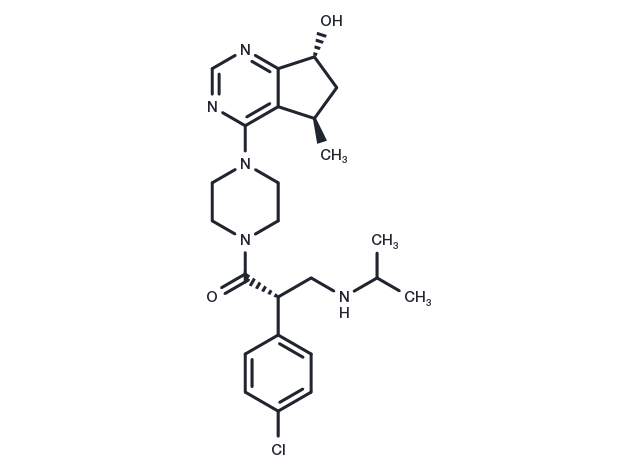Powder: -20°C for 3 years | In solvent: -80°C for 1 year


Ipatasertib (GDC-0068) (GDC-0068), a highly specific pan-Akt inhibitor, targets Akt1/2/3 with IC50 of 5 nM/18 nM/8 nM, respectively.

| Pack Size | Availability | Price/USD | Quantity |
|---|---|---|---|
| 2 mg | In stock | $ 39.00 | |
| 5 mg | In stock | $ 55.00 | |
| 10 mg | In stock | $ 80.00 | |
| 25 mg | In stock | $ 143.00 | |
| 50 mg | In stock | $ 239.00 | |
| 100 mg | In stock | $ 369.00 | |
| 1 mL * 10 mM (in DMSO) | In stock | $ 56.00 |




| Description | Ipatasertib (GDC-0068) (GDC-0068), a highly specific pan-Akt inhibitor, targets Akt1/2/3 with IC50 of 5 nM/18 nM/8 nM, respectively. |
| Targets&IC50 | Akt3:8 nM, Akt2:18 nM, Akt1:5 nM |
| In vitro | Testing against a broad panel of 230 kinases, GDC-0068 only inhibits 3 kinases by >70% at 1 μM concentration (PRKG1α, PRKG1β, and p70S6K, with IC50 of 98 nM, 69 nM, and 860 nM, respectively). GDC-0068 displays >100-fold selectivity for Akt over PKA with IC50 of 3.1 μM. In LNCaP, PC3 and BT474M1 cells, GDC-0068 treatment inhibits the phosphorylation of the Akt substrate, PRAS40 with IC50 of 157 nM, 197 nM, and 208 nM, respectively. Furthermore, GDC-0068 selectively inhibits cell cycle progression and viability of cancer cell lines driven by Akt signaling, including those with defects in the tumor suppressor PTEN, oncogenic mutations in PIK3CA, and amplification of HER2, with strongest effects in HER2+ and Luminal subtypes. [1-4] |
| In vivo | Oral administration of GDC-0068 in PC3 prostate tumor xenografts model induces down-regulation of p-PRAS40. In BT474-Tr xenografts, GDC-0068 treatment reduces pS6 and peIF4 g levels, re-localizes FOXO3a to nucleus, and induces feedback upregulation of HER3 and pERK. Administration of GDC-0068 exhibits potent antitumor efficacy in multiple xenograft tumor models, including the PTEN-deficient prostate cancer models LNCaP and PC3, the PIK3CA H1047R mutant breast cancer model KPL-4, and MCF7-neo/HER2 tumor model. [1-4] |
| Kinase Assay | Kinase Assay: The fluorescence polarization assay for ATP competitive inhibition is done as follows: mPI3Kα dilution solution (90 nM) is prepared in fresh assay buffer (50 mM Hepes pH 7.4, 150 mM NaCl, 5 mM DTT, 0.05% CHAPS) and kept on ice. The enzyme reaction contains 0.5 nM mouse PI3Kα (p110α/p85α complex purified from insect cells), 30 μM PIP2, PF-04691502 (0, 1, 4, and 8 nM), 5 mM MgCl2, and 2-fold serial dilutions of ATP (0–800 μM). Final dimethyl sulfoxide is 2.5%. The reaction is initiated by the addition of ATP and terminated after 30 minutes with 10 mM EDTA. In a detection plate, 15 uL of detector/probe mixture containing 480 nM GST-Grp1PH domain and 12 nM TAMRA tagged fluorescent PIP3 in assay buffer is mixed with 15 uL of kinase reaction mixture. The plate is shaken for 3 minutes, and incubated for 35 to 40 minutes before reading on an LJL Analyst HT. |
| Cell Research | GDC-0068 is prepared in DMSO and stored, and then diluted with appropriate medium before use[2]. The 384-well plates are seeded with 2,000 cells per well in a volume of 54 μL per well followed by incubation at 37°C under 5% CO2 overnight (~16 hours). Compounds (e.g., GDC-0068) are diluted in DMSO to generate the desired stock concentrations then added in a volume of 6 μL per well. All treatments are tested in quadruplicates. After 4 days incubation, relative numbers of viable cells are estimated using CellTiter-Glo and total luminescence is measured on a Wallac Multilabel Reader. The concentration of drug resulting in IC50 is calculated from a 4-parameter curve analysis (XLfit) and is determined from a minimum of 3 experiments. For cell lines that failed to achieve an IC50, the highest concentration tested (10 μM) is listed[2]. |
| Synonyms | GDC-0068, RG7440 |
| Molecular Weight | 458 |
| Formula | C24H32ClN5O2 |
| CAS No. | 1001264-89-6 |
Powder: -20°C for 3 years | In solvent: -80°C for 1 year
DMSO: 85 mg/mL (185.6 mM)
Ethanol: 85 mg/mL (185.6 mM)
H2O: < 1 mg/mL (insoluble or slightly soluble)
You can also refer to dose conversion for different animals. More
bottom
Please see Inhibitor Handling Instructions for more frequently ask questions. Topics include: how to prepare stock solutions, how to store products, and cautions on cell-based assays & animal experiments, etc.
Ipatasertib 1001264-89-6 Cytoskeletal Signaling PI3K/Akt/mTOR signaling Akt Protein kinase B RG-7440 GDC-0068 RG7440 Inhibitor PKB GDC 0068 inhibit GDC0068 RG 7440 inhibitor
